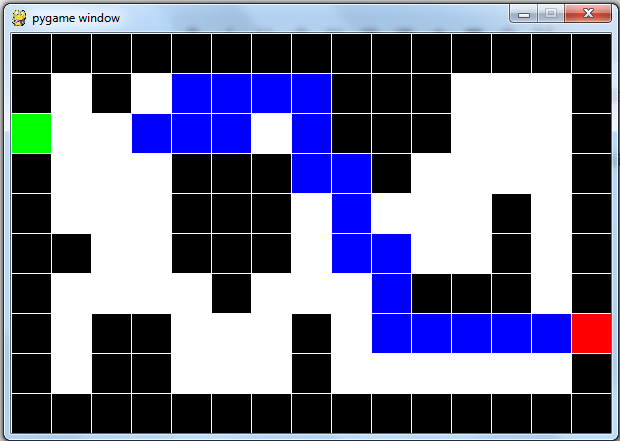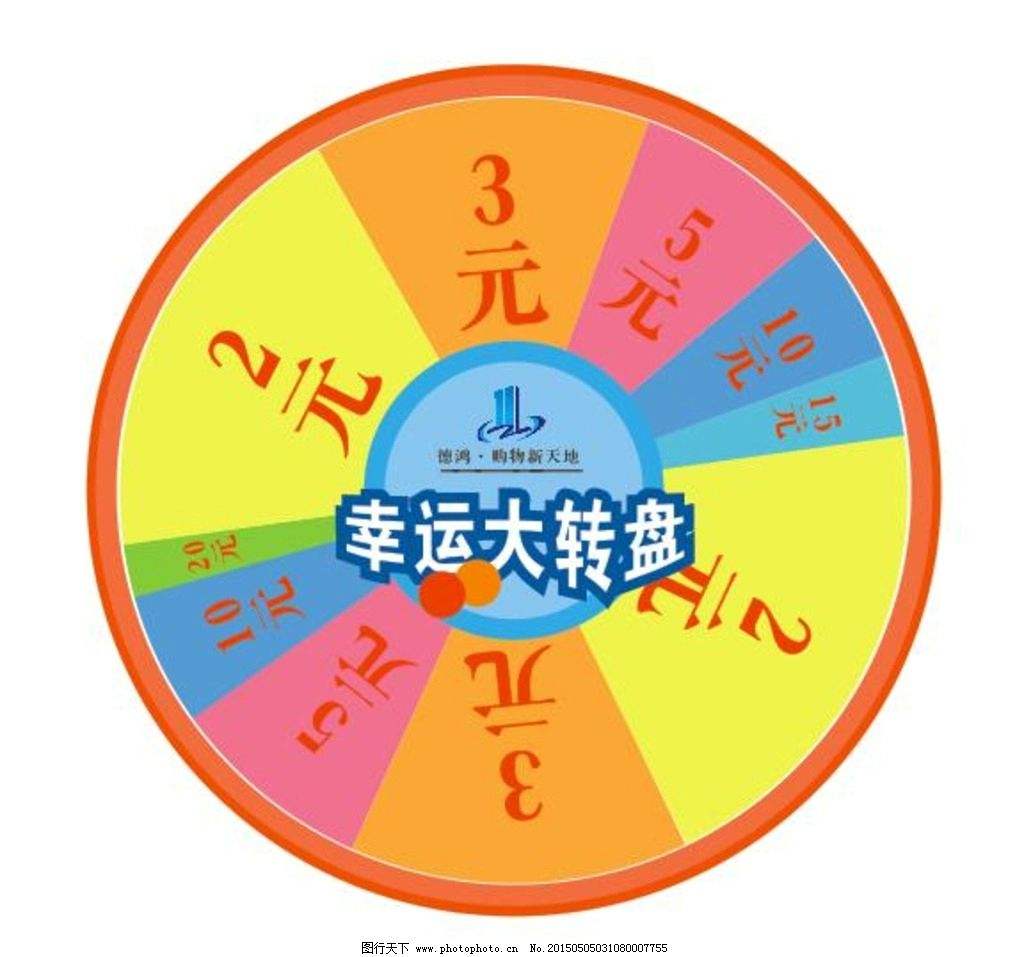游戏编程中的人工智能(Python改编)
2017-04-10 09:26
477 查看
本文改编自Mat Buckland的游戏开发中的人工智能技术中的Chapter 3帮助Bob回家,C++代码重新用python来实现(本文所有遗传算法相关代码均改编值Mat的C++代码,如有雷同,纯属巧合)。
Mat在本章节中详细的描述了如何利用遗传算法来帮助Bob从迷宫的起始点走到终点。具体效果如下图,红色是起点,绿色是终点,蓝色是寻找的路径:

。
a)初始化:设置进化代数计数器t=0,设置最大进化代数T,随机生成M个个体作为初始群体P(0)。
b)个体评价:计算群体P(t)中各个个体的适应度。
c)选择运算:将选择算子作用于群体。选择的目的是把优化的个体直接遗传到下一代或通过配对交叉产生新的个体再遗传到下一代。选择操作是建立在群体中个体的适应度评估基础上的。
d)交叉运算:将交叉算子作用于群体。遗传算法中起核心作用的就是交叉算子。
e)变异运算:将变异算子作用于群体。即是对群体中的个体串的某些基因座上的基因值作变动。
群体P(t)经过选择、交叉、变异运算之后得到下一代群体P(t+1)。
f)终止条件判断:若t=T,则以进化过程中所得到的具有最大适应度个体作为最优解输出,终止计算。
本文会通过Python来一步一步实现如何利用遗传算法帮助Bob回家。
然后我们需要对Bob的行走方式进行编码,因为只有四个方向,所以我们可以用0-3来代表Bob的行走方向:0-北, 1-南,2-东,3-西。
然后将0-3转化成2进制00,01,10,11,这样我们就可以生成一串随机长度(需要可以被2整除)的字符串来代表Bob的行进路线了。比如 1111000010100101就可以解码成11-11-00-00-10-10-01-01,也就是3-3-0-0-2-2-1-1(西-西-北-北-东-东-南-南)。

1. 随机生成一个在0到总适应度之间的值
2. 遍历种群,对每个染色体的适应度进行累加
3. 当遇到第一个大于1中生成的适应度的染色体时,停止累加,返回该染色体
适应度越大的染色体被选中的概率越大
完整的代码如下,注意本文仅使用了最基本的遗传算法操作,所以会经常陷入局部最优而难以达到终点,我们会在后续的文章中来对遗传算法进行优化。
原创作品,转载请注明出处。
Mat在本章节中详细的描述了如何利用遗传算法来帮助Bob从迷宫的起始点走到终点。具体效果如下图,红色是起点,绿色是终点,蓝色是寻找的路径:

。
遗传算法
遗传算法是一种经典的进化算法,本文不再讲解遗传算法的概念,基本运算过程的介绍从百度百科拷贝如下:a)初始化:设置进化代数计数器t=0,设置最大进化代数T,随机生成M个个体作为初始群体P(0)。
b)个体评价:计算群体P(t)中各个个体的适应度。
c)选择运算:将选择算子作用于群体。选择的目的是把优化的个体直接遗传到下一代或通过配对交叉产生新的个体再遗传到下一代。选择操作是建立在群体中个体的适应度评估基础上的。
d)交叉运算:将交叉算子作用于群体。遗传算法中起核心作用的就是交叉算子。
e)变异运算:将变异算子作用于群体。即是对群体中的个体串的某些基因座上的基因值作变动。
群体P(t)经过选择、交叉、变异运算之后得到下一代群体P(t+1)。
f)终止条件判断:若t=T,则以进化过程中所得到的具有最大适应度个体作为最优解输出,终止计算。
本文会通过Python来一步一步实现如何利用遗传算法帮助Bob回家。
数学建模
首先我们需要对地图进行建模,地图有四种情况:起点,终点,障碍物,通路。我们利用一个二维数组来表示Bob需要穿越的地图,1代表障碍,0代表通路,5是起点,8是终点:BobsMap = [ [1, 1, 1, 1, 1, 1, 1, 1, 1, 1, 1, 1, 1, 1, 1], [1, 0, 1, 0, 0, 0, 0, 0, 1, 1, 1, 0, 0, 0, 1], [8, 0, 0, 0, 0, 0, 0, 0, 1, 1, 1, 0, 0, 0, 1], [1, 0, 0, 0, 1, 1, 1, 0, 0, 1, 0, 0, 0, 0, 1], [1, 0, 0, 0, 1, 1, 1, 0, 0, 0, 0, 0, 1, 0, 1], [1, 1, 0, 0, 1, 1, 1, 0, 0, 0, 0, 0, 1, 0, 1], [1, 0, 0, 0, 0, 1, 0, 0, 0, 0, 1, 1, 1, 0, 1], [1, 0, 1, 1, 0, 0, 0, 1, 0, 0, 0, 0, 0, 0, 5], [1, 0, 1, 1, 0, 0, 0, 1, 0, 0, 0, 0, 0, 0, 1], [1, 1, 1, 1, 1, 1, 1, 1, 1, 1, 1, 1, 1, 1, 1] ]
然后我们需要对Bob的行走方式进行编码,因为只有四个方向,所以我们可以用0-3来代表Bob的行走方向:0-北, 1-南,2-东,3-西。
然后将0-3转化成2进制00,01,10,11,这样我们就可以生成一串随机长度(需要可以被2整除)的字符串来代表Bob的行进路线了。比如 1111000010100101就可以解码成11-11-00-00-10-10-01-01,也就是3-3-0-0-2-2-1-1(西-西-北-北-东-东-南-南)。
def BinToInt(self, bins): val = 0 multiplier = 1 for bin in bins[::-1]: val += bin * multiplier multiplier *= 2 return val def Decode(self, bits): directions = [] for i in range(0, len(bits), self.GeneLength): ThisGene = [] for j in range(self.GeneLength): ThisGene.append(bits[i+j]) directions.append(self.BinToInt(ThisGene)) return directions
染色体
根据数学建模的分析,我们可以随机生成一串二进制数据来表示该算法中的染色体,在遗传算法的初始,我们会随机生成一系列随机的该染色体来表示Bob可能进行尝试的回家路径。class Genome(object): def __init__(self, num_bits): #check num_bits length self.Fitness = 0.0 self.Bits = [] for i in xrange(num_bits): self.Bits.append(random.randint(0, 1)) # 这个循环可以用map来代替 map(lambda _:random.randint(0,1), xrange(num_bits))
种群初始化
定义好染色体之后,我们就可以进行种群的初始化了,种群的初始化就是生成一系列随机的染色体,在初始化种群时,我们同时将算法中需要用的的几个参数全部初始化,FittestGenome表示的是该种群中最佳的Bob行走路径的索引,BestFitnessScore表示的是该种群中最佳行走路径的适应度,TotalFitnessScore表示的是种群的总适应度(该适应度用于个体选择),Generation表示的进化代数:def CreateStartPopulation(self): self.Genomes = [] for i in xrange(self.PopSize): self.Genomes.append(Genome(self.ChromoLength)) self.FittestGenome = 0 self.BestFitnessScore = 0.0 self.TotalFitnessScore = 0.0 self.Generation = 0 return
选择运算
赌轮盘的选择方式(商场里经常会出现这样的活动,一个大轮盘,越贵重的奖项在轮盘中占有的比例越小),适应度越高的路径(越接近终点的路径)越容易被选择运算选中而遗传到下一代:
1. 随机生成一个在0到总适应度之间的值
2. 遍历种群,对每个染色体的适应度进行累加
3. 当遇到第一个大于1中生成的适应度的染色体时,停止累加,返回该染色体
适应度越大的染色体被选中的概率越大
def RouletteWheelSelection(self): fSlice = random.random() * self.TotalFitnessScore cfTotal = 0.0 SelectedGenome = 0 for i in xrange(self.PopSize): cfTotal += self.Genomes[i].Fitness if cfTotal > fSlice: SelectedGenome = i break return self.Genomes[SelectedGenome]
交叉运算
生成一个随机数,如果该随机数大于交叉概率,则不进行交叉,如果随机数小于交叉概率,则在染色体上随机选择一个点,将父亲与母亲的染色体进行交叉,生成新的子代染色体def Crossover(self, mum, dad): if random.random() > self.CrossoverRate or mum == dad: return mum, dad cp = random.randint(0, self.ChromoLength - 1) return mum[:cp]+dad[cp:], dad[:cp]+mum[cp:]
变异运算
顾名思义,对染色体上的每个bit进行概率性的变异操作(0-1),变异运算在遗传算法中有利于算法走出局部最优。def Mutate(self, bits): #bits is a list for i in xrange(len(bits)): if random.random() < self.MutationRate: if bits[i] == 0: #if bitArray, it's more easy to reverse bits[i] = 1 if bits[i] == 1: bits[i] = 0 return bits
适应度
适应度的计算很简单,越靠近终点的行走方式适应度越高,注意在计算路径的时候,如果碰到路障或者是走出了边界,Bob的位置不会移动。def TestRoute(Path): posX = startPos[0] posY = startPos[1] for direction in Path: if direction == 0: #North if posY - 1 > 0 and BobsMap[posY - 1][posX] != 1: posY -= 1 elif direction == 1: #South if posY + 1 < MapHeight and BobsMap[posY + 1][posX] != 1: posY += 1 elif direction == 2: #East if posX + 1 < MapWidth and BobsMap[posY][posX + 1] != 1: posX += 1 elif direction == 3: #West if posX - 1 >= 0 and BobsMap[posY][posX - 1] != 1: posX -= 1 else: print "Unknown direction: ", direction DiffX = abs(posX - endPos[0]) DiffY = abs(posY - endPos[1]) return 1.0/(DiffX + DiffY + 1)
进化吧, Bob
在每次进化的Epoch中,我们都会更新本次进化的适应度,并根据适应度来判断是否Bob是否已经到达了终点,如果没有到达终点,则对种群进行选择操作,直到选择出来的染色体已经达到了我们需要的数量:def UpdateFitnessScores(self): self.FittestGenome = 0 self.BestFitnessScore = 0.0 self.TotalFitnessScore = 0.0 for i in xrange(self.PopSize): directions = self.Decode(self.Genomes[i].Bits) self.Genomes[i].Fitness = TestRoute(directions) #print directions, self.Genomes[i].Fitness self.TotalFitnessScore += self.Genomes[i].Fitness if self.Genomes[i].Fitness > self.BestFitnessScore: self.BestFitnessScore = self.Genomes[i].Fitness self.FittestGenome = i if self.Genomes[i].Fitness == 1: #Bob已经找到回家的路啦~~~~ print "Found Path" print "Path is :", self.ShowPath(self.Decode(self.Genomes[i].Bits)) self.Busy = False return def Epoch(self): self.UpdateFitnessScores() if not self.Busy: return NewBabies = 0 BabyGenomes = [] while NewBabies < self.PopSize: mum = self.RouletteWheelSelection() dad = self.RouletteWheelSelection() #print mum.Bits, dad.Bits baby1 = Genome(0) baby2 = Genome(0) baby1.Bits, baby2.Bits = self.Crossover(mum.Bits, dad.Bits) baby1.Bits = self.Mutate(baby1.Bits) baby2.Bits = self.Mutate(baby2.Bits) BabyGenomes.append(baby1) BabyGenomes.append(baby2) NewBabies += 2 self.Genomes = BabyGenomes self.Generation += 1 #print self.Generation, self.BestFitnessScore return
整合
最后,我们将上面的代码整合起来,就可以形成一个完整的自动寻找Bob回家的遗传算法。当然,仅有这些没有办法显示的看到Bob是如何尝试寻找回家的方法的,我们需要一个GUI来对每次进化的最优路径进行显示,本文采用的是pygame,如何使用本文不再赘述,请参考用 Python 和 Pygame 写游戏 - 从入门到精通。完整的代码如下,注意本文仅使用了最基本的遗传算法操作,所以会经常陷入局部最优而难以达到终点,我们会在后续的文章中来对遗传算法进行优化。
原创作品,转载请注明出处。
# -*- coding: utf-8 -*-
import random
import pygame
from pygame.locals import *
from sys import exit
BobsMap = [ [1, 1, 1, 1, 1, 1, 1, 1, 1, 1, 1, 1, 1, 1, 1], [1, 0, 1, 0, 0, 0, 0, 0, 1, 1, 1, 0, 0, 0, 1], [8, 0, 0, 0, 0, 0, 0, 0, 1, 1, 1, 0, 0, 0, 1], [1, 0, 0, 0, 1, 1, 1, 0, 0, 1, 0, 0, 0, 0, 1], [1, 0, 0, 0, 1, 1, 1, 0, 0, 0, 0, 0, 1, 0, 1], [1, 1, 0, 0, 1, 1, 1, 0, 0, 0, 0, 0, 1, 0, 1], [1, 0, 0, 0, 0, 1, 0, 0, 0, 0, 1, 1, 1, 0, 1], [1, 0, 1, 1, 0, 0, 0, 1, 0, 0, 0, 0, 0, 0, 5], [1, 0, 1, 1, 0, 0, 0, 1, 0, 0, 0, 0, 0, 0, 1], [1, 1, 1, 1, 1, 1, 1, 1, 1, 1, 1, 1, 1, 1, 1] ]
MapHeight = len(BobsMap)
MapWidth = len(BobsMap[0])
startPos = [14, 7]
endPos = [0, 2]
# 15 * 40 = 600, 10 * 40 = 400
block_size = 40
def TestRoute(Path): posX = startPos[0] posY = startPos[1] for direction in Path: if direction == 0: #North if posY - 1 > 0 and BobsMap[posY - 1][posX] != 1: posY -= 1 elif direction == 1: #South if posY + 1 < MapHeight and BobsMap[posY + 1][posX] != 1: posY += 1 elif direction == 2: #East if posX + 1 < MapWidth and BobsMap[posY][posX + 1] != 1: posX += 1 elif direction == 3: #West if posX - 1 >= 0 and BobsMap[posY][posX - 1] != 1: posX -= 1 else: print "Unknown direction: ", direction DiffX = abs(posX - endPos[0]) DiffY = abs(posY - endPos[1]) return 1.0/(DiffX + DiffY + 1)
class Genome(object):
def __init__(self, num_bits): #check num_bits length
self.Fitness = 0.0
self.Bits = []
for i in xrange(num_bits):
self.Bits.append(random.randint(0, 1)) # This loop can be replaced by: map(lambda _:random.randint(0,1), xrange(num_bits))
def _show(self):
print self.Bits, self.Fitness
class GaBob(object):
def __init__(self, cross_rat, mut_rate, pop_size, num_bits, gene_len):
self.Genomes = []
self.PopSize = pop_size
self.CrossoverRate = cross_rat
self.MutationRate = mut_rate
self.ChromoLength = num_bits
self.GeneLength = gene_len
self.FittestGenome = 0
self.BestFitnessScore = 0.0
self.TotalFitnessScore = 0.0
self.Generation = 0
self.Busy = False
pass
def Run(self):
self.CreateStartPopulation()
self.Busy = True
def _showPopulation(self):
for i in xrange(self.PopSize):
print self.Genomes[i].Bits
def CreateStartPopulation(self): self.Genomes = [] for i in xrange(self.PopSize): self.Genomes.append(Genome(self.ChromoLength)) self.FittestGenome = 0 self.BestFitnessScore = 0.0 self.TotalFitnessScore = 0.0 self.Generation = 0 return
# 赌轮盘的选择方式:
# 1. 随机生成一个在0到总适应度之间的值
# 2. 遍历种群,对每个染色体的适应度进行累加
# 3. 当遇到第一个大于1中生成的适应度的染色体时,停止累加,返回该染色体
# 适应度越大的染色体被选中的概率越大
def RouletteWheelSelection(self): fSlice = random.random() * self.TotalFitnessScore cfTotal = 0.0 SelectedGenome = 0 for i in xrange(self.PopSize): cfTotal += self.Genomes[i].Fitness if cfTotal > fSlice: SelectedGenome = i break return self.Genomes[SelectedGenome]
def Mutate(self, bits): #bits is a list for i in xrange(len(bits)): if random.random() < self.MutationRate: if bits[i] == 0: #if bitArray, it's more easy to reverse bits[i] = 1 if bits[i] == 1: bits[i] = 0 return bits
def Crossover(self, mum, dad): if random.random() > self.CrossoverRate or mum == dad: return mum, dad cp = random.randint(0, self.ChromoLength - 1) return mum[:cp]+dad[cp:], dad[:cp]+mum[cp:]
def BinToInt(self, bins): val = 0 multiplier = 1 for bin in bins[::-1]: val += bin * multiplier multiplier *= 2 return val def Decode(self, bits): directions = [] for i in range(0, len(bits), self.GeneLength): ThisGene = [] for j in range(self.GeneLength): ThisGene.append(bits[i+j]) directions.append(self.BinToInt(ThisGene)) return directions
def UpdateFitnessScores(self):
self.FittestGenome = 0
self.BestFitnessScore = 0.0
self.TotalFitnessScore = 0.0
for i in xrange(self.PopSize):
directions = self.Decode(self.Genomes[i].Bits)
self.Genomes[i].Fitness = TestRoute(directions)
#print directions, self.Genomes[i].Fitness
self.TotalFitnessScore += self.Genomes[i].Fitness
if self.Genomes[i].Fitness > self.BestFitnessScore:
self.BestFitnessScore = self.Genomes[i].Fitness
self.FittestGenome = i
if self.Genomes[i].Fitness == 1:
#we found, stop
print "Found Path"
print "Path is :", self.ShowPath(self.Decode(self.Genomes[i].Bits))
self.Busy = False
return
def Epoch(self):
self.UpdateFitnessScores()
if not self.Busy:
return
NewBabies = 0
BabyGenomes = []
while NewBabies < self.PopSize:
mum = self.RouletteWheelSelection()
dad = self.RouletteWheelSelection()
#print mum.Bits, dad.Bits
baby1 = Genome(0)
baby2 = Genome(0)
baby1.Bits, baby2.Bits = self.Crossover(mum.Bits, dad.Bits)
baby1.Bits = self.Mutate(baby1.Bits)
baby2.Bits = self.Mutate(baby2.Bits)
BabyGenomes.append(baby1)
BabyGenomes.append(baby2)
NewBabies += 2
self.Genomes = BabyGenomes
self.Generation += 1
#print self.Generation, self.BestFitnessScore
return
def ShowPath(self, Path):
pathStr = ""
for direction in Path:
if direction == 0: #North
pathStr += "-North"
elif direction == 1: #South
pathStr += "-South"
elif direction == 2: #East
pathStr += "-East"
elif direction == 3:
pathStr += "-West"
else:
pathStr += "-Unknown direction: ", direction
return pathStr
def Started(self):
return self.Busy
def Stop(self):
self.Busy = False
return
def GetFittestDirection(self):
return self.Decode(self.Genomes[self.FittestGenome].Bits)
# pos = (x, y), top left position of the rect
def set_block(screen, color, pos):
top_side_rect = Rect(pos[0], pos[1], block_size, 1)
right_side_rect = Rect(pos[0] + block_size, pos[1], 1, block_size)
bottom_side_rect= Rect(pos[0], pos[1] + block_size, block_size, 1)
left_side_rect = Rect(pos[0], pos[1], 1, block_size)
center_rect = Rect(pos[0]+1, pos[1]+1, block_size-1, block_size-1)
pygame.draw.rect(screen, (255, 255, 255), top_side_rect)
pygame.draw.rect(screen, (255, 255, 255), right_side_rect)
pygame.draw.rect(screen, (255, 255, 255), bottom_side_rect)
pygame.draw.rect(screen, (255, 255, 255), left_side_rect)
pygame.draw.rect(screen, color, center_rect)
def set_path(screen, color, path):
posX = startPos[0]
posY = startPos[1]
for direction in path:
if direction == 0: #North
if posY - 1 > 0 and BobsMap[posY - 1][posX] != 1:
posY -= 1
elif direction == 1: #South
if posY + 1 < MapHeight and BobsMap[posY + 1][posX] != 1:
posY += 1
elif direction == 2: #East
if posX + 1 < MapWidth and BobsMap[posY][posX + 1] != 1:
posX += 1
elif direction == 3: #West
if posX - 1 >= 0 and BobsMap[posY][posX - 1] != 1:
posX -= 1
else:
print "Unknown direction: ", direction
if [posX, posY] == startPos:
continue
current_pos = (posX*block_size, posY*block_size)
set_block(screen, color, current_pos)
if __name__ == "__main__":
CROSSOVER_RATE = 0.7
MUTATION_RATE = 0.015
POP_SIZE = 140
CHROMO_LENGTH = 70
GENE_LENGTH = 2
test_gaBob = GaBob(CROSSOVER_RATE, MUTATION_RATE, POP_SIZE, CHROMO_LENGTH, GENE_LENGTH)
test_gaBob.Run()
pygame.init()
screen = pygame.display.set_mode((600, 400), 0, 32)
while True:
for event in pygame.event.get():
if event.type == QUIT:
exit()
screen.fill((255, 255, 255))
#set_block(screen, (255,0,0), (100, 100))
for yIdx, rowItem in enumerate(BobsMap):
for xIdx, blockItem in enumerate(rowItem):
if blockItem == 1:
block_pos = (xIdx*block_size, yIdx*block_size)
set_block(screen, (0, 0, 0), block_pos)
elif blockItem == 5:
block_pos = (xIdx*block_size, yIdx*block_size)
set_block(screen, (255, 0, 0), block_pos)
elif blockItem == 8:
block_pos = (xIdx*block_size, yIdx*block_size)
set_block(screen, (0, 255, 0), block_pos)
if test_gaBob.Started():
test_gaBob.Epoch()
set_path(screen, (0, 0, 255), test_gaBob.GetFittestDirection())
pygame.display.update()
相关文章推荐
- 游戏编程中的人工智能 四 (Python改编)
- [Python]游戏编程--人工智能1
- [Python]游戏编程--人工智能3
- [Python]游戏编程--人工智能2
- Python:pygame游戏编程之旅六(游戏中的声音处理)
- Python:pygame游戏编程之旅六(游戏中的声音处理)
- 深入 GalCon:Python、游戏开发和人工智能
- Python:pygame游戏编程之旅一(Hello World)
- 深入 GalCon:Python、游戏开发和人工智能
- Python:pygame游戏编程之旅五(游戏界面文字处理详解)
- Python:pygame游戏编程之旅五(游戏界面文字处理详解)
- 深入 GalCon:Python、游戏开发和人工智能
- Python:pygame游戏编程之旅七(pygame基础知识讲解1)
- Python:pygame游戏编程之旅二(自由移动的小球)
- Python:pygame游戏编程之旅三(玩家控制的小球)
- Python:pygame游戏编程之旅七(pygame基础知识讲解1)
- 游戏编程中的人工智能技术【1】
- 深入 GalCon:Python、游戏开发和人工智能
- Python:pygame游戏编程之旅二(自由移动的小球)
- 使用 Python 进行游戏脚本编程
